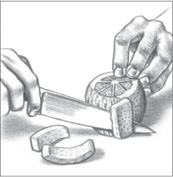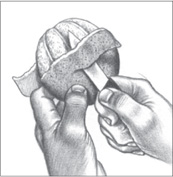French Classics Made Easy (61 page)
Read French Classics Made Easy Online
Authors: Richard Grausman

⅓ cup (70g) sugar
4 tablespoons (½ stick; 60g) butter
Juice of 1 lime or lemon
½ cup dark rum
4 small bananas (see Note), peeled
¼ cup (25g) sliced almonds, toasted
1.
In a large skillet, stir the sugar over medium-high heat until it melts and lightly caramelizes. Remove the pan from the heat.
2.
Stir in the butter, lime juice, and ¼ cup of the rum. Return the pan to low heat.
3.
Place the bananas in the pan and baste with the sauce. Cover and cook over low heat until tender, 5 to 10 minutes.
4.
To flame: Pour the remaining ¼ cup rum into the pan; remove from the heat. Keeping your face and anything flammable well away from the pan, carefully ignite the rum by touching a match to the pan’s edge. Baste the bananas until the flames die. Transfer to a serving platter or plates, sprinkle with toasted almonds, and serve immediately.
NOTE
Use bananas that still have a little green at the stem.
IN ADDITION
There are many rums with varying flavors. Most of the rum used in France comes from the island of Martinique, and its flavor differs from that of most other rum-producing islands. As hard as I tried to develop an appreciation for it while living in France, I never did. My preference is for one of the dark, full-flavored blended rums from Puerto Rico or Jamaica, and my favorite rum is a Demerara rum from Guyana, but it is hard to find and I regularly use Myers’s dark rum. If you use an ultra-high-proof rum, be careful of the added fire power when flaming.
STRAWBERRIES
WITH SABAYON
[FRAISES AU SABAYON]
The French
sauce sabayon
is fashioned after the Italian zabaglione. In Italy it is made with Marsala, a sweet Italian wine, while in France it is made with a dry white wine and often flavored with an eau-de-vie or liqueur. Sabayon can be served warm, cold, or frozen, and is excellent with both fresh and poached fruit.
SERVES 6
2 pints strawberries
3 egg yolks
¼ cup plus 2 tablespoons (90g) sugar
⅓ cup dry white wine
1 to 2 tablespoons kirsch or Grand Marnier, to taste
½ cup (50g) sliced almonds, toasted
1.
Place the berries in individual glass or crystal compote dishes or goblets.
2.
Bring a saucepan filled with water to a gentle simmer. Place the egg yolks, sugar, and wine in a metal or heatproof glass mixing bowl and set the bowl over the simmering water. (Or use a 2-quart double boiler.)
3.
Using an electric hand mixer or whisk, beat the egg-and-sugar mixture until it is thick and foamy, about 5 minutes. At this point the sauce will be warm to the touch. Beat in the kirsch.
4.
Serve the sabayon either warm or cold. If it is to be served cold, place the bowl into a larger bowl of ice and water and continue beating until it is chilled. (A sabayon to be served cold can be made 24 hours in advance and frozen. Pour the cold sauce into a cold bowl or container and freeze. When frozen, the sauce will be thick and can be spooned over the berries.)
5.
To serve: Pour the sabayon over the berries, sprinkle with the almonds, and serve.
T
OASTING
N
UTS
Toasting nuts heightens their flavor. You can toast them in the oven, under the broiler, or in a toaster oven. Spread them out on a pan and toast at 400°F to 425°F for 3 to 4 minutes, shaking the pan once or twice. The nuts will start to give off a wonderful, rich aroma, and they will become darker in color and sometimes take on a shine as the oil comes to the surface. Take care not to go too far or they will smell burnt and have an unpleasant flavor. Pour the nuts out of the baking pan as soon as they’re done to keep them from continuing to cook.
PEARS POACHED
IN PORT WINE
[POIRES AU PORTO]
Several years ago, when it seemed as though everyone was poaching pears in red wine, I was reminded of Fernand Point’s recipe for prunes poached in red wine and port (see Variation) and was inspired to try pears instead. By poaching in port, which has a certain sweetness, you can eliminate a large quantity of the sugar normally used in poaching fruit. You can use any kind of port, but if you have only a top-quality bottle, you might want to invest in a less-expensive port for use in cooking.
Serve the pears with Madeleines (
page 254
) or Almond Tuiles (
page 252
). Any excess poaching liquid remaining after the pears have been served can be refrigerated or frozen for future use in poaching pears.
SERVES 6
6 pears, preferably Comice or Bosc, peeled
3 cups dry red wine
1½ cups port
½ cup minus 2 teaspoons (100g) sugar
Peeled zest and juice of 1 orange
Peeled zest and juice of 1 small lemon
1.
Place the pears upright in a deep pan just large enough to hold them. Add all of the other ingredients and bring to a boil over medium-high heat. Reduce the heat and simmer gently, uncovered, until the pears are tender, 15 to 20 minutes for unripened pears and 5 to 10 minutes for ripened, ready-to-eat pears. Allow the pears to cool in the poaching liquid.
2.
Place the pears in a serving bowl and strain the liquid over them. Refrigerate for 2 hours or more. (This can be done a day or two in advance.)
3.
Serve 1 pear per person in a bowl or on a plate with some of the poaching liquid.
VARIATION
P
RUNES
P
OACHED IN
P
ORT
W
INE
[PRUNEAUX AU PORTO]
Substitute 2 pounds of pitted prunes for the pears. In step 1, cook the prunes until tender, about 10 minutes. Serve 3 or 4 prunes in wine glasses with some of the poaching liquid. If desired, drizzle each serving with 1 tablespoon heavy cream.
ORANGES
IN CHAMPAGNE
[ORANGES AU CHAMPAGNE]
While a French cook would never dream of making this simple, elegant, classic dessert with anything but French Champagne, I find that Champagne-style sparkling wines produced in this and other countries are very suitable for it.
I like to add to the elegance of this dessert by serving it in a cut crystal bowl or in individual goblets. And to gild the lily, I usually accompany the oranges with Ladyfingers (
page 259
) or Almond Tuiles (
page 252
).
The best oranges to use are seedless so the sections will be solid and not left with holes made by the seeds. The navel, the familiar seedless orange, is known in France as the Thompson, after the man who developed it. Use oranges in the winter months, at the height of their season, when they are deep orange in color and full of flavor. In addition to the navel, a number of other citrus fruits work well for this dessert, even though they have some seeds. Some of these are Valencia
oranges, Mineola and other tangelos, and blood oranges.
SERVES 8 to 10
H
OW TO
S
ECTION AN
O
RANGE
Sectioning an orange—or grapefruit, lemon, or lime—means releasing the segments of fruit from their membranes. The resulting segments will be more attractive: shiny, bright in color, and tender (so your guests won’t have to chew through the fruit's tough membrane). Though the sectioning process takes a bit of time, it can absolutely make the dish, as in Oranges in Champagne (
page 285
), Duck à l’Orange (
page 131
), or Endive and Pink Grapefruit Salad (
page 28
).
PEELING METHOD ONE:
Start by cutting off one end of the orange so you can see the exposed flesh. With a sharp knife, follow the fruit’s contours and slice off strips of peel, taking care to remove the membrane but without removing too much flesh.
PEELING METHOD TWO:
Hold the paring knife as you would to peel an apple, but instead of just drawing your knife along the flesh, carefully move it up and down with a sawing motion at the same time to cut through the thick skin more easily. Keep the knife under the membrane but as close to it as possible so as not to cut away too much flesh. Continue cutting around the orange until all the skin and membrane are removed.
SECTIONING:
Section the oranges by carefully cutting toward the center as close to each sectional membrane as possible. This will yield shiny, smooth individual orange segments. Once all the segments have been removed, squeeze the membranes that are left to extract any juices.
8 oranges, preferably a seedless variety, such as navel
1 bottle demi-sec Champagne or similar sparkling wine
1.
Peel and section all of the oranges, making sure they are completely free of all membranes (see “How to Section an Orange,” facing page, but reserve the juice for another use—or drink it on the spot, as I do). Place the oranges in a colander (they will hold their shape better than if allowed to sit in their own juice) and refrigerate until ready to serve.
2.
Place the sectioned oranges in a serving bowl or individual dessert bowls and bring to the table with a chilled bottle of Champagne.
3.
Pour the Champagne over the oranges and serve.
SORBET
A fresh fruit sorbet captures the essence of fruit in a frozen state. It provides an ideal ending for a meal, especially during the summer months when the variety and quality of fresh fruit is at its best.
Easy to make, sorbets are simply sweetened fruit purées frozen in an ice-cream machine. They will keep in your freezer for several weeks.


